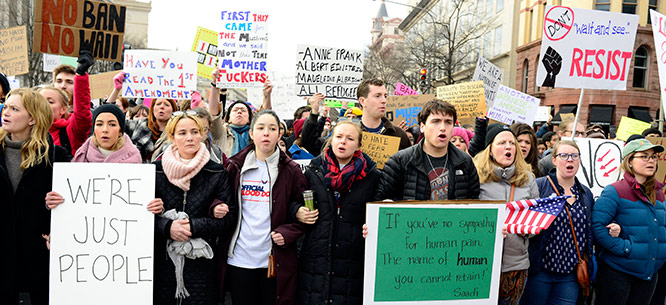Signs of Our Time
Signs of Our Time
The outpouring of witty protest signs at recent anti-Trump protests is something new in the repertoire of social movements. But the thrilling horizontalism that the signs reflect has its limits.

One of the most impressive features of the protests against Trump and his ilk that have mushroomed since January 20 has been all the handmade protest signs. Scrawled and drawn on poster boards, many employ pithy satire, arresting images, and/or a shrewd grasp of history to express outrage against and a determination to resist the sordid crew that now rules our country.
Here’s a tiny sample from the demonstration last Sunday against Trump’s anti-immigrant order that filled Lafayette Park and the streets in front of the White House:
- “Never Again Means Now”
- side-by-side photos of Anne Frank and a Syrian girl with a blood-streaked face
- “E Pluribus Unum – It’s on the Damn Money”
- “1924- Japanese Immigration Ban” – “1942- Japanese-American Internment”
- “Will Trade Racists for Refugees”
- “Atheists for Muslims”
- “We are the Wall and Trump Will Pay”
- “I’m With Her” next to a drawing of the Statue of Liberty
- “I Learned About This in Hebrew School”
- “Donald Trump is a Bad Person with Terrible Ideas”
This outpouring of graphic self-expression is something new in the repertoire of social movements. I have been attending all sorts of protests in Washington, D.C. and other cities since the mid-1960s and cannot recall another time when so many individuals took it on themselves to create the media that became, in effect, the message.
In the throng that gathered before the White House, many people were snapping photos of their favorite signs; some rushed over to thank or even hug the holder of a poster they particularly liked. Since this demonstration had been called just one day before—and was publicized exclusively on social media—it featured no speakers. So the crowd of several thousand and their signs were the story.
It’s a thrilling, as well as frightening, moment in history. The sign-makers are clearly alarmed in a deeply personal way—as women, immigrants, people of different faiths, Americans—by what Trump is saying and doing. Many are neither veteran activists nor committed to a broadly left-wing vision.
However, what makes this innovation so thrilling should also be a cause for concern for the future prospects of the anti-Trump resistance. The “horizontal,” warmly inclusive character of the burgeoning movement has certainly helped swell its numbers. Anyone who is angry at the new administration for pretty much any reason is welcome to express her or his feelings in any peaceful manner she or he desires. But such individualized messages may soon lose their allure and potency. If we attempt to oppose everything that Trump and his minions are doing, the point of our protests could soon become confusing and make it difficult to attract new participants.
Those who flocked to the mass marches of the 1960s and ‘70s did it differently. Most were organized by a broad coalition composed of institutions, each of which had one or more respected leaders. Whether aimed at passing laws to abolish Jim Crow, to get the United States out of Vietnam, or to press for women’s rights, they agreed on a set of demands and, sometimes, even a set of slogans.
Take the celebrated March for Jobs and Freedom in August 1963. Members of the crowd of 250,000 lofted signs printed and distributed in advance by unions like the United Auto Workers, civil rights groups like the Southern Christian Leadership Conference and SNCC, and religious bodies like the National Council of Churches. Such slogans, as “We Demand Equal Rights Now!” and “End Segregation Rules in Public Schools” certainly lacked the wit and freshness of those one can see at today’s anti-Trump protests. But the demonstrators who carried them knew exactly what kind of changes they wanted from their government and their fellow citizens. And most belonged to groups which kept pressing for those changes long after their buses had chugged out of downtown D.C.
I do not know how exactly to organize the kind of powerful coalition we need to stop the Trump administration and the GOP Congress—and soon, the Supreme Court—from carrying out their terrible plans. I do know it will have to be one that can unite around a few common, urgent demands and be able both to mount street protests and mobilize people to campaign and vote for Democrats who share those objectives. Americans who believe in a tolerant democracy of equals have not faced so great a peril since the McCarthy era or, perhaps, the late 1930s. We need a strategy as serious and concerted as is the challenge before us.
The future leaders of the anti-Trump coalition should encourage resisters to keep designing posters as smart and original as the ones I saw last week. They help turn demonstrating into more of a joy and less of an obligation. But the point is to build a movement that can defeat this malevolent administration and shape our future.
Michael Kazin is editor of Dissent.






